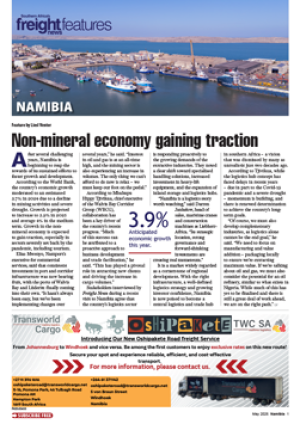The EU import control
system (EUICS) for
advanced cargo declarations
– with entry summary
(ENS) declarations having
to be submitted by ocean
carriers 24 hours in advance
of a vessel’s departure – has
settled in and been operating
smoothly in its first 15
months of use, according to
two shipping line executives.
For other modes, the
24-hour period falls away,
and is replaced with a
specified period prior to the
flight or a vehicle’s arrival
at the airport or port of first
landing.
Contrary to fears at its
introduction about noncompliant
shippers, FTW
was told that SA exporters
connected into the system
reasonably promptly, and
few of the consequences of
late involvement have come
to light.
But, as Iain McIntosh,
regional sales manager
of MOL said, a lot of SA
shippers were used to doing
it for the US route, and the
six-month grace period for
the EU system seemed to
give most adequate notice.
A few faced challenges
at the beginning, he added,
but soon adjusted to the new
system.
“Certain of these
challenges came to light
when ships were delayed, or
boxes were late,” McIntosh
told FTW. “It required some
work to enter things in
properly in these cases, but
things soon settled down.”
Ron Frick, MD of DAL
Agency, noted a couple of
hiccups at the start of the
EUICS regime.
“I don’t think that
European customs
authorities were ready for
the extra volume of work,”
he said. “But this was all
sorted out pretty quickly.
“Our SA fruit exporters
also had to get all their
ducks in a row, with the
packing houses getting used
to the system. But we had no
complaints in the end.”
The warning flags
that were raised by some
members of the SA
freight industry about the
possibility of numbers of
“do not load” signals being
received on exports from
this country were also soon
lowered.
Carriers receive three
message types from EU
customs. The first is a
green light which means
all documentation is up to
speed, and cargo can be
loaded. The second calls
for inspection at the first
port of call, while the third
message is that “do not
load” instruction, which
flags suspicious cargo. Such
an instruction has serious
implications for the lines in
terms of deadfreight – and
deadfreight penalties would
have seen carriers severely
compromised.
“But,” McIntosh said,
“I’m not aware of any do
not loads. SA is unlikely
to face such an instruction,
as it is relatively low-risk
– especially with the main
things we export to Europe,
like automotive products and
fruit.”
Frick agreed. “The type
of products we load out of
Africa, like fruit, is not high
risk. It’s only in countries
like China, where there are
lots of high-tech exports,
that ‘do not loads’ are likely
to appear.”
Both were also adamant
that the EUICS was
designed for the right
reasons and wasn’t an issue
for honest traders. And
that most customers they
dealt with were legitimate
– particularly on a mature
trade like the Europe route.
CAPTION
SA exporters connected into the system reasonably promptly.

